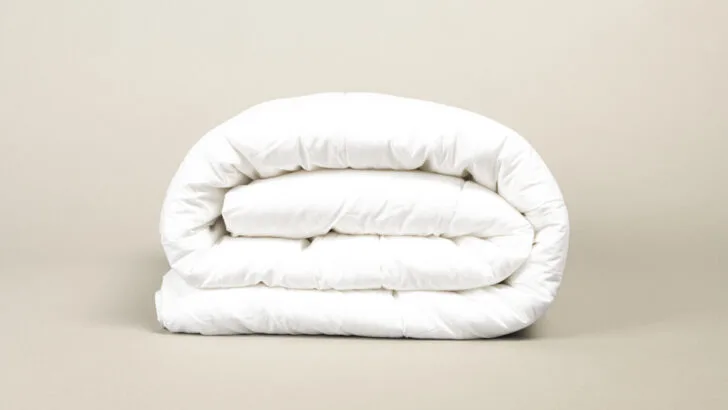Figuring out how often we should wash our comforter can be confusing. It doesn’t get that dirty, right? Or what’s the rule of thumb for how often it should be cleaned?
Your comforter should be washed at least three to five times a year. If animals sleep on your bed, then wash your comforter every month.
A duvet and a comforter are not the same item, but sometimes they share the same names.
You can also place a blanket over the comforter to catch any crumbs, dust, dander, and animal fur so that you don’t have to wash your comforter so often. You can preserve your comforters by purchasing two comforter bed sets and rotating them every month.
How Often Should You Wash Your Comforter?
Washing your bedding is one of the most important tasks in the home. You will spend a third of your life in your bed, so you have to make sure it’s clean.
So how often should you wash your comforter? Should you wash it as often as you wash your sheets and pillowcases?
You must wash your comforter at least three to five times a year, but you may have to wash it more if you have small children, animals, or if you eat in bed.
If you wash your comforter 4 times a year, then it is best to wash your comforter once per season. Wash your comforter in the middle of summer, fall, winter, and spring.
For people with kids’ comforters, twin comforters, full comforters, and full wide comforters, they may wash the bed’s comforter in their washing machine or in their apartment’s washing machine.
But for people with queen and king beds, their washing machine might not be large enough to wash a queen or king-size comforter.
In contrast, wash your sheets and pillowcases at least once a week. If you sweat or you don’t shower before you go to bed, then you may have to wash your sheets and pillowcases twice a week.
How to Wash Your Comforter
The detergents and methods you used to wash your comforter depend on the material of the comforter, and the instructions on the tag. All comforters have a tag located somewhere on the product.
The other bedding items that come in the bed, the sheets, and the comforter set will all have their own tag.

Items that are sold together in a bedset are likely to have the same washing instructions. If your washer can handle the load, wash all the bedding items together.
When it comes time to dry the comforter or the comforter and the comforter case, do not put the temperature too high. There aren’t actually many fabrics that need to be dried at high temperatures. Put the temperature at medium or low.
Once the comfort is dry, place it back on your bed. Then jump and land on your comforter so you can feel the warmth. That’s the best part!
What Is a Comforter? Is It a Blanket?
Before you wash your comforter, it’s best to know which bed items in your home are comforters, blankets, quilts, and duvets. The first thing you should know is that the comforter and the duvet might not be the same item.
Depending on your location, a comforter could be a thick blanket placed on top of the bed or it could be a large pillow like a blanket that is covered in a protective sheet.
The word comforter is used more in the United States. The United Kingdom uses the word duvet.
What is a Duvet?
A duvet is not the same as a blanket. Think of it as a giant pillow that covers your entire bed. The duvet has two pieces: the main pillowy part and the case around the pillow. The duvet case can be washed weekly to biweekly, while the main pillow part should be washed four times a year.
How to Protect a Comforter
Some people have small washing machines, so in order to wash their comforter, they have to take it to a laundromat. This is just another chore that has to be added to your day. That’s why washing a comforter is a lot of work.
What can you do to extend the time between washes?
- Place a protective sheet over the comforter to protect it from dust, and from animal dander.
- Purchase 2 comforters and rotate them between uses. When the first comforter becomes dirty or smells, store it away until you have time to wash it. In the meantime, you can use the alternate comforter so you aren’t cold when you sleep.
- Instead of purchasing a comforter, you can purchase a duvet with a protective case. So, when the duvet or comforter case becomes dirty, you can strip the duvet case off of the main blanket and throw that in the washer. You won’t have to wash the pillow blanket inside of it. Washing the fabric case is far easier than washing the entire duvet.
How to Store a Comforter
If you live in a region that experiences all four seasons, then you don’t really need the comforter during the late spring to early fall. It will be too warm and you’ll be sweating in your bed if you have a comforter on.
When the heart appears and the late spring turns into summer, store your comforter away for the cold seasons and bring out your summer comforter or light blanket.
To store your comforter properly, wash the comforter or the comforter pillow and comforter case. Once the comforter pieces are washed and dried, go over the entire comforter with a lint roller and remove any stray thread or hair.
Now, store your comforter in a protective bag and place it somewhere that isn’t affected by water, moisture, and humidity, or bugs. Make sure the protective bag does not have any holes, rips, or tears.
Comforters that come in a bed set should be stored with the other bed set items, like the sheets and the pillowcases.
Conclusion to How Often You Should Wash Your Comforter
Wash your comfort at least three to five times a year. If you have small children or animals, wash your duvet at least once a month. You should wash your sheets and pillowcases once or twice a week.
Comforters purchased in a bed set will have the same washing instructions as the other items in the bed set. When drying your comforter or duvet, the temperature should be set to medium or low.


